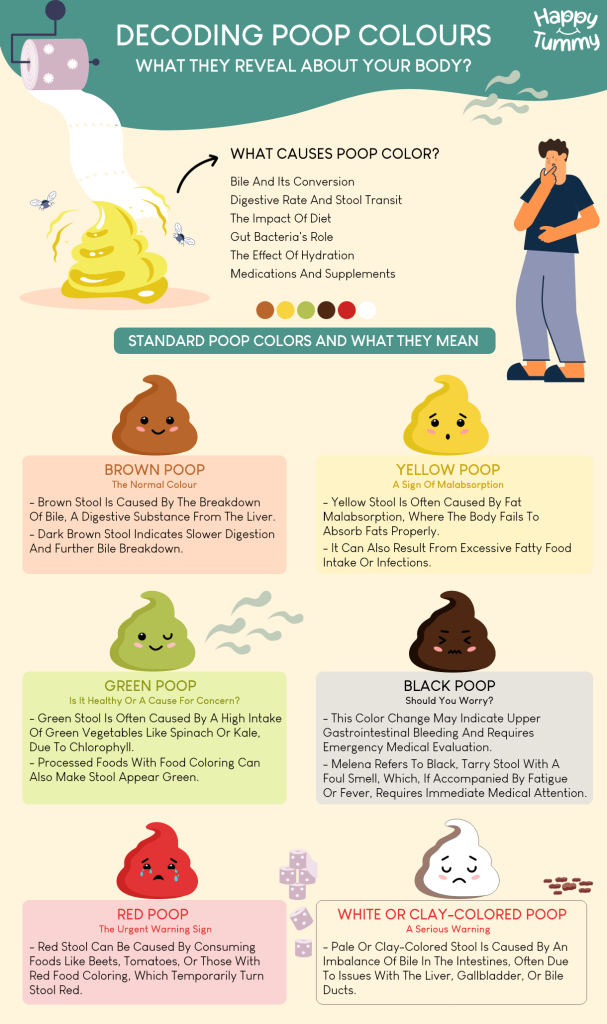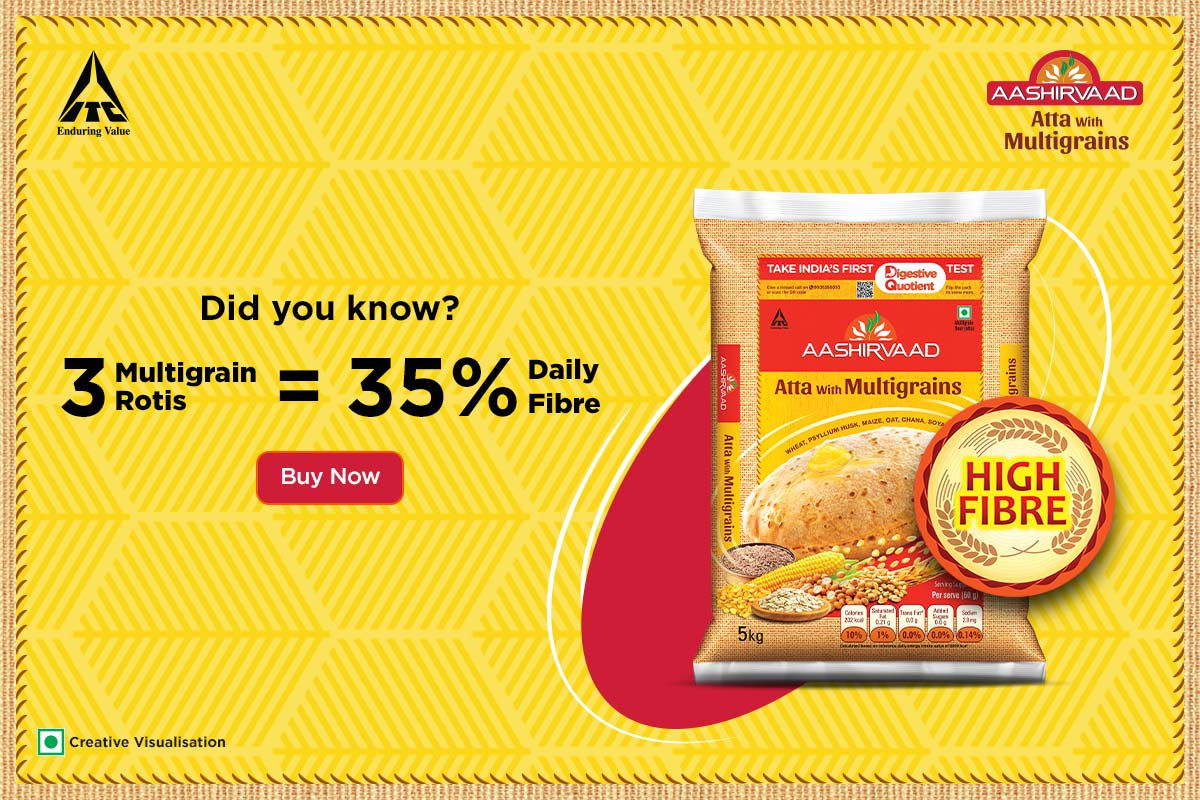Table of Contents
Have you ever noticed that your stool colour changes and wondered what that indicates? Shockingly, your poop can say much about your digestive health. Brown to green, yellow to black, every colour has its story to reveal about the inner functioning of your body.
Although specific colour changes are regular and do not indicate any health problems, others can be the first sign of certain health conditions that require discussion with a healthcare provider.
This post will unravel the poop colour meanings so you can know what is possibly happening in your body and when you need to see a healthcare provider. So, let us plunge into the Science of Stool!

What Causes Poop Colour?
The colour of your stool depends on different factors, each of which performs a particular role in your digestive system. The most serious causes can be divided into:
#1 Bile and its Conversion:
The liver produces bile, which plays a vital role in the digestion of fats.[1] When bile is released into the intestines, it is initially a yellow-green colour. As it passes through the digestive tract, gut bacteria break it down, chemically altering it, until it becomes brown.[2]
This process is what typically gives stool its standard brown colour. When this process is hindered by something, it can cause the stool to have a different colour.
#2 Digestive Rate and Stool Transit:
The speed at which food moves through your bowel affects the colour of the faeces. Bile requires time to be broken down in the digestive system, and when food passes through the system too quickly, the bile may not be completely broken down, which can cause green stool.
However, on the other hand, when the food moves too slowly, it can result in constipation, which can cause darker bowel movements as the bile has been processed over a prolonged period. It shouldn’t be confused with melena (dark stools).
#3 The Impact of Diet:
Your diet can have a significant impact on the colour of your stool. For example:
- Green foods, such as spinach or kale, can contain chlorophyll that causes the stool to turn green.
- Red and purple foods: Beets, cranberries, and even food colouring can turn stool red or purple, and this is typically not something to be concerned about unless other symptoms are also present.
- High-fat foods: When your body is unable to digest fats effectively, you may notice a yellowish hue in your stool. This isn’t often seen in healthy individuals, but is common in people having “malabsorption” issues.
- Foods or supplements that contain iron: When a person eats a large amount of iron, it may cause the stool to become darker, and in some cases, black. Remember that black stool in melena is distinct from other forms of black stool. Melena will be tarry in appearance, and it will have a foul odour too.
#4 Gut Bacteria’s Role:
The trillions of bacteria that reside in your intestines are significant to digestion. These bacteria play a crucial role in the digestion of food, as well as the synthesis of vitamins and the regulation of stool consistency.
Alterations to your gut microbiome (via illness, changes to your diet, or antibiotics) and gut infections may also impact the processing of food and, by extension, the colour of your stool.
For example, the excessive growth of certain bacteria may cause the formation of gases or other substances that alter the appearance and odour of stool.
Generally, only a one-shade variance is observed. If you notice a more significant colour change, it is advisable to consult with your healthcare expert.
#4 The Effect of Hydration:
Hydration is essential to digestive health. This is because dehydration may cause the stools to become more complex and darker as water is extracted from the waste.[3] So, proper hydration is essential.
#5 Medications and Supplements:
Some drugs or supplements may alter the colour of your bowel movements. For example, iron supplements are recognised for turning the stool darker than usual to a blackish colour.
The colour of the stool may also change due to laxatives or antibiotics that speed up the movement of food in your digestive tract.
Aashirvaad Atta, in collaboration with a team of expert nutritionists, has devised the Digestive Quotient, which assesses your digestive score out of 100. Take this quick 2-minute test to know your Digestive Quotient.
Standard Poop Colours and What They Mean
Below we will discuss the different poop colours and what they indicate about your health
#1 Brown Poop: The Normal Colour
- What Causes Brown Stool?
The standard stool colour is brown, primarily due to the breakdown of bile. Bile is a yellow-green digestive substance that is produced by the liver. As it travels back and forth through the intestines, bile undergoes chemical changes and turns a brown colour. [4]
- What This Reveals About Your Digestive Health:
The stool is brown, indicating that your digestive system may be functioning well. It may indicate that the food is moving through your intestines at a normal speed and that bile is being digested properly.
- Possible Alternatives of Brown Stool:
Brown stool can be light or dark depending on the pace at which the food that is causing the stool is moving within your intestines. A light brown colour of the stool might be an indication of proper digestion.[5] Conversely, the dark brown colour of the faeces may be an indication of a slower digestion process wherein the bile has been allowed to break down further.
#2 Yellow Poop: A Sign of Malabsorption
- What Causes Yellow Stool?
Fat malabsorption is a frequent cause of yellow stool, resulting from the body’s inability to absorb fats in food as it should. This condition may result in increased fat in the faeces, which makes them yellowish and even greasy. Yellow stool may also be a result of excessive consumption of fatty foods or some infections. [6]
- What This Means Regarding Your Digestive Health:
A variety of yellows means different things.
- pale yellow + greasy – Might be malabsorption
- yellowish- Might be due to dietary factors like turmeric, chronic stress, or infections like Giardia
- yellow- Might be due to bile issues, chronic pancreatitis, etc. [7]
Potential Relations to Conditions:[8] [9]
| Yellow Shade | Possible Causes | Conditions It May Lead To |
| Pale Yellow + Greasy | Might be malabsorption | Nutrient deficiencies, weight loss, diarrhoea |
| Yellowish | Might be due to dietary factors like turmeric, chronic stress, or infections like Giardia | Digestive upset, bloating, discomfort, infection |
| Yellow | It might be due to bile issues, chronic pancreatitis, etc. | Gallbladder issues, liver problems, pancreatitis, jaundice |
#3 Green Poop: Is It Healthy or a Cause for Concern?
- What Causes Green Stool?
Green stool is most often caused by a high intake of green vegetables, such as spinach or kale, in the diet due to the presence of chlorophyll. Processed foods may also contain food colouring, which can make the stool appear green. Additionally, when stool travels through the intestines too quickly, there may be insufficient time for bile to be broken down, resulting in stool that is green in colour.[10]
- What This Tells You About Your Digestive Health:
Green stool may indicate that the digestion is quick. Bile is not thoroughly broken down when food passes through the intestines too quickly, which causes the stool to have a greenish colour. [11]
This can be a sign that your digestive system is being stressed, usually through diarrhoeal infections like Salmonella or gastrointestinal upset.
- Potential Links to Conditions:
Besides dietary causes, green stool could occasionally be associated with conditions that lead to diarrhoea, including gastrointestinal infections or food intolerance. When green stool is chronic and accompanied by other symptoms, such as cramping or bloating, it may indicate the presence of a condition that requires medical examination.
#4 Black Poop: Should You Worry?
- What Causes Black Stool?
Iron supplements, as well as some medications and dark-coloured foods, may cause your stool to appear black. These are usually harmless and temporary changes in the colour of the stool.[12]
- Potential Links to Conditions:
Melena represents a special kind of black, tarry stool, characterised by an unpleasant, strongly odorous smell. When accompanied by conditions such as fatigue or fever, it requires immediate treatment. This colour may indicate that you might have upper gastrointestinal bleeding. It may be caused by conditions such as stomach ulcers, gastritis, or oesophageal varices, and emergency medical attention is required to diagnose and treat the cause.[13]
#4 Red Poop: The Urgent Warning Sign
- What Causes Red Stool?
The common causes of red stool include consuming foods in high amounts, such as beets, tomatoes, or foods with red food colouring. These can temporarily cause the stool to become red.
- What This Tells You About Your Digestive Health:
The red colour of the stool is usually bright, and it might be a sign of lower gastrointestinal tract bleeding. When you see the red stool following the intake of red-coloured foods, there is nothing much to worry about.
Nevertheless, when red stool occurs without an obvious dietary explanation, it is a significant alarm bell of blood loss, which may be caused by hemorrhoids or anal fissure.[14]
- Potential Links to Conditions:
Red stool can be related to hemorrhoid, anal fissure, or other serious gastrointestinal issues, such as diverticulosis. Nevertheless, red stool that lasts longer than a single bowel movement or is accompanied by pain, fatigue, and other unusual symptoms should not be overlooked; consulting a doctor is recommended.[15]
#5 White or Clay-Coloured Poop: A Serious Warning
- What Causes Pale or Clay-Coloured Stool?
Clay coloured or pale stool is seen in cases of an imbalance of bile in the intestines. The brown colour of the stool is caused by bile, and failure might be due to problems with the liver, gallbladder, or bile ducts. The cause of pale stool may be the presence of conditions that obstruct the bile flow, including liver disease, hepatitis, or gallstones. [16]
- What this Indicates about Your Digestive Health:
A clay-coloured or pale stool is a serious sign that there may be an obstruction or a problem with the production or drainage of bile. It can be a sign of an issue with the liver or bile ducts, whereby the bile is unable to reach the intestines and change the stool to its normal brown colour.[17] It requires a serious medical evaluation.
- Possible Connections to Conditions:
Pale stool can be a symptom of other diseases, such as hepatitis, cirrhosis, or gallstones, as they affect the production and secretion of bile. Stool colour may also be a significant indicator of health, and any drastic changes should be reviewed with your regular physician, especially when coupled with related symptoms such as jaundice (yellowing of the skin or eyes) or abdominal pain. [18]
Conclusion
Although poop color is not the most regular topic of the conversation, it tells much about the health of your digestive tract. Being aware of the different colours and their interpretations will help you diagnose a potential problematic situation before it occurs and know when to intervene.
One should keep in mind that the standard stool colour and consistency are dependent on various factors, such as diet, hydration, and the presence of a healthy intestinal microbiome. To minimise digestive issues, adopt a healthy lifestyle that includes a balanced diet, plenty of water, and regular consumption of probiotics, which will help maintain a healthy digestive system.
Still, if you notice any abnormal or prolonged changes in the colour of your stool, it is always prudent to seek medical assistance to help exclude any underlying disease issues. It is not a reason to be scared to discuss any concerns with a healthcare specialist, so that you can be sure that your digestive health is balanced.
Knowledge is power. Be in charge of your health! You can always rely on our expert advice when making choices for your body’s health and well-being.
Frequently Asked Questions
Yes, the stool colour may be different and may depend on factors such as diet or medication.
Stress can hassle your digestive system, yes. It can lead to bowel irregularities or diarrhoea, which may cause a change in the colour of the stool, including the appearance of green stools.
To maintain a standard stool colour, it is essential to follow a balanced diet rich in fibre, which includes a variety of fruits, vegetables, and whole grains. Water, along with a balanced diet and the avoidance of excessive consumption of processed and fatty foods, can also help maintain a standard stool colour and promote healthy digestion.















